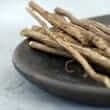Background
- Manchurian thorn tree (Aralia mandshurica) is a member of the Araliaceae family and is native to the eastern regions of Russia, northern China, and Korea.
- The bark, roots, and flowers of Manchurian thorn have been used traditionally to treat a wide range of conditions. Teas made from different parts of the tree were historically used in Russia to treat fatigue, weakness, headaches, depression, immune weakness, and stress.
- Manchurian thorn is often prepared in combination with other herbs. The combination product Araloxâ„¢ contains A. mandshurica and Engelhardtia chrysolepis. Research suggests that Araloxâ„¢ may decrease fat and body weight in non-exercising, obese, otherwise healthy women. Preliminary evidence suggests that Manchurian thorn may protect against some forms of irregular heartbeat and radiation damage.
References
- Abidov MT, del Rio MJ, Ramazanov TZ, et al. Effects of Aralia mandshurica and Engelhardtia chrysolepis extracts on some parameters of lipid metabolism in women with nondiabetic obesity. Bull Exp Biol Med 2006;141(3):343-346. View Abstract
- Brekhman II, Dardymov IV. New substances of plant origin which increase nonspecific resistance. Annu Rev Pharmacol 1969;9:419-430. View Abstract
- Burgos R, Hancke J, Caceres DD, et al. Hepatotoxic Effect of Aralia mandshurica dried root extract in pigs. Phytother Res 1997;11(1):59-61.
- Dong WC. [Determination of total aralosides in Aralia mandshurica grown in Jilin and Liaoning Provinces]. Zhong Yao Tong Bao 1986;11(7):44-46. View Abstract
- Dzhumaeva TI. [Optimization of the extraction process in obtaining a dry extract of the leaves of Aralia mandshurica]. Farmatsiia 1980;29(3):17-21. View Abstract
- Fu KC, Hsu SK, Wu RH, et al. [Pharmacognostical studies on the Chinese drug ci-lao-yia--the bark of Aralia mandshurica Rupr. et Maxim]. Yao Xue Xue Bao 1964;11:824-833. View Abstract
- Iakubovskii MM, Pentiuk AA, Khmelnitskii OK, et al. [The activity of the lipid peroxidation processes in the mucosa of the rat small intestine and its morphofunctional state under acute irradiation and the administration of combined preparations created on a base of highly dispersed silica]. Radiats Biol Radioecol 1997;37(3):366-371. View Abstract
- Iskenderov GB. [The metabolism of araloside A]. Farmakol Toksikol 1991;54(6):33-35. View Abstract
- Lishmanov IuB, Maslov LN, Arbuzov AG, et al. [Cardioprotective, inotropic, and anti-arrhythmia properties of a complex adaptogen "Tonizid"]. Eksp Klin Farmakol 2008;71(3):15-22. View Abstract
- Lutomski J, Gorecki P, Halasa J. [Immunologische Eigenschaften der Saponosidfraktion aus Aralia mandshurica]. Planta Med 1981;42(6):116-117. View Abstract
- Mal'chukovskii LB, Takhtobaeva GM, Kopylova IE, et al. [Determination of the sum of aralosides A, B, C in the roots of Aralia mandshurica]. Farmatsiia 1972;21(6):45-47. View Abstract
- Martinez B, Staba EJ. The physiological effects of Aralia, Panax and Eleutherococcus on exercised rats. Jpn J Pharmacol 1984;35(2):79-85. View Abstract
- Maslov LN, Guzarova NV. [Cardioprotective and antiarrhythmic properties of preparations from Leuzea carthamoides, Aralia mandshurica, and Eleutherococcus senticosus]. Eksp Klin Farmakol 2007;70(6):48-54. View Abstract
- Maslov LN, Lishmanov YB, Arbuzov AG, et al. Antiarrhythmic activity of phytoadaptogens in short-term ischemia-reperfusion of the heart and postinfarction cardiosclerosis. Bull Exp Biol Med 2009;147(3):331-4. View Abstract
- Zhuravlev IuN, Artiukova EV, Kozyrenko MM, et al. [Genetic relationships among Far Eastern species of the family Araliacea inferred by RAPD analysis]. Genetika 2003;39(1):57-63. View Abstract







